Heather Reyburn's Blog, page 3
July 1, 2020
Mirambeena Horses
Having grown up dreaming about, living and riding horses; when my eldest daughter expressed an interest in riding, my first reaction was to encourage her and find her a suitable pony. Unfortunately my husband wasn’t quite so enthusiastic—he had grown up believing that all horses bit at one end and kicked at the other and had never had the opportunity to learn otherwise. Nevertheless, with our daughter’s enthusiasm and my encouragement, we were able to find a pony to get her started. Living on the land, feed and care was never a problem and over the course of a year or so, our daughter proved to be a responsible and dedicated horse owner and rider, never waiving in her enthusiasm for horses and all they entailed.
The first pony we had was a Connemara mare who had been sent to stud at a neighbour’s place and after four years of running with the stallion, had failed to conceive. She was getting on in years and surprisingly strong, however, she taught our daughter that kindness, mixed with a degree of strength and a strong will eventually beats all odds. Once they were confident with each other, trotting and cantering without mishap and keen to move on, we prepared for our introduction to Pony Club.
One week before their first Pony Club rally, we arrived home just on dark to see the mare standing over what appeared to be a foal? A foal? Yes, a foal! She had given birth to a little black colt in pouring rain, surrounded by thunder and lightning – the first we had experienced in months of drought. In spite of being regularly checked by the farrier, previous owner and many experienced horsey friends, no-one had suspected she was in foal. A wonderful surprise—but not so good for heading off to Pony Club the following weekend.
Due to our daughter’s disappointment and the knowledge that the mare needed a break while her young foal settled in, I continued to look around for another pony. We found a Welsh Mountain Pony who had been bred and ridden by a determined young girl who had outgrown him. The little grey pony remained with us for several years until he was passed on to another Pony Club family. In that time, both our daughters and our son rode him, having years of fun, thrills and spills until they moved on to other mounts. Our next pony was a larger one—a pretty 14hh palomino mare, ironically called Goldie. She had been ignored, sitting in a paddock for six years following her owner’s death and proved to be quite a challenge for my eldest daughter. After spending hours after school and every weekend, she eventually got the mare more flexible, reasonably well educated and ready to start competing. For the next four years, Goldie and my daughter became almost as one, able to enjoy every discipline. They competed in gymkhanas, shows, dressage, sporting, barrel racing and show-jumping, winning more trophies than we had room to display. Goldie became the flag bearer at the Rodeo when they won a title, mustered cattle and sheep and was used for pony rides for visiting children. While she continued to teach others to ride, my girls moved more into show-jumping, hacking and dressage. Their horses, although ridden daily, became more specialised.
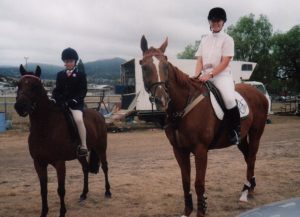
Around the time we were going to shows almost every weekend, I decided to purchase a horse for myself. Unfortunately for me, but to both girls delight, my horse turned out to be a kind and capable all-rounder and my opportunities to ride him slowly disappeared as the girls took him over. My role as truck driver, cook, stable hand and assistant dogs-body, filled my spare time, leaving little or no riding time.
While our son switched his love to motor-bikes early in his riding career (as many boys seem to do), the girls continued riding horses. Now, many years later, our eldest daughter still has her old show-jumper, retired and living the high life, while the young grandchildren are just beginning.
For those of you who have a child who is desperate to own a horse, these are the lessons I have learned from horses:
Owning a horse teaches us how to be responsible for another life, how to be caring and kind. They teach us to be thrifty as the expenses in owning a horse are numerous – and they teach us how to budget and save. They teach us how to keep fit and disciplined, in order to get the best out of both ourselves and our horse. They keep us honest and well behaved as we are too busy and too tired to get into trouble. Above all else, they teach us how to love and how it feels to be loved in return.
If you have a child, or a hankering yourself to own a horse, learn all you can, do it—and allow the horse to teach you lessons you will remember all your life.
May 25, 2020
Dante and Chloe – The Maremma Sheepdogs
Dog attacks on sheep are common in Australia – not just dingo attacks, but frequently domestic dogs or dogs that have become feral. The domestic packs of dogs seem to be more of a problem for farms within easy reach of a town. Unfortunately many dog owners either don’t realise, or don’t care that their unrestrained dogs frequently band together with others and go walkabout at night, often creating problems for farmers, even if the dog is usually a gentle family pet by day.
Living only twelve kilometres from town, we endured many attacks on our sheep,
with some attacks killing or maiming a good percentage of our flock. We tried electrifying
the entire property, locking the sheep in a small floodlit paddock and doing random night
checks. However, the attacks continued and so we decided to purchase a Maremma Sheepdog as we had heard very good reports about them.
The Maremma Sheepdog is a very old breed, indigenous to central Italy (Tuscany and
Lazio regions) and used for centuries to guard sheep from wolves. Introduced to Australia in
1982, the breed was quickly recognised as a valuable asset to a sheep farmer as its good
temperament fitted in with family and farm life while centuries of natural instincts provided a
dedicated protector.
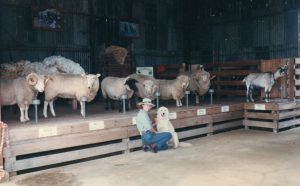
We purchased Dante as a nine week old puppy and learned very quickly, that a
Maremma was like no other dog we had ever had the pleasure to meet. A true “shift worker”,
Dante visited the house each day, enjoying a play with the children and eating his breakfast.
Then he would head off for a sleep on the dam bank or anywhere he fancied, only barking or
showing any sign of life, if an unknown vehicle, person or animal set foot on our property.
During the night however, he patrolled the boundaries, barking ferociously at intruders and
constantly checking on every animal and bird. Unfortunately, we soon learned that the male Maremma (in spite of having been de-sexed), was capable of caring for a much bigger
property than ours, and Dante began the habit of extending his patrol to the next door
property where he closely monitored the cattle. His daily rounds involved crossing an
increasingly busy road and sadly, his life ended early one morning when he and a fast moving vehicle collided. During Dante’s life with us however, we only ever experienced one dog attack, involving a large pack of town dogs. In that instance, we intervened as his frantic
barking woke us and were able to save many sheep that otherwise would not have made it.
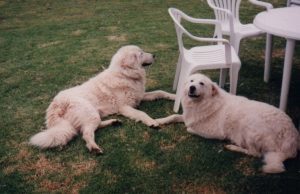
Following Dante, we decided to purchase a female Maremma and so Chloe came to
live with us. She was a treasure and in her reign, we never even lost a lamb to foxes. She was content to stay within our boundaries and although naturally wary of strangers, would quietly place herself between the visitor and the family or any of our animals. During the day, she would often be seen lying outside the hayshed where the chooks roamed free, and have little chicks and bantams sitting on her back or head. She never harmed a single bird or animal and we laughed when chicks would walk down her nose—she would remain absolutely still but go cross-eyed as they got to the end of her nose and jumped off. One wintry night I arrived home late from a meeting in town, to see her lying next to a perfectly mustered flock of sheep in the middle of the paddock. When I got close, a layer of frost on her thick, double layered coat, glistened. We rarely heard her bark during the day but as soon as the sun began to set, she would head off on her rounds and bark at anything she wasn’t happy about. Pity help anything or anyone who entered our property!
Like all dogs, sadly their lives are shorter than ours and Chloe passed away suddenly,
lying under her favourite tree on the farm.
April 28, 2020
Squeak – The Emu
During the 1990’s, farming Ostriches and Emus became quite popular, with a demand for their eggs (to be blown for carving), feathers and in particular, Emu oil.
It was, in theory, a great idea, particularly as Emu oil had been tested and proven to be very good for the skin. However, like many great ideas, the practicalities were more complex, in spite of Emus being native to Australia and extremely hardy. Nevertheless, we decided to add Emu farming to our portfolio.
After obtaining the necessary permits, building the ideal pens and paddocks to hold the minimum allowance of fifty birds, we took delivery of our Emus.
Over the following two years, they grew well, ate an enormous amount of grain, and then the processing facilities in Queensland closed down. Our bad luck! The closest market became Victoria—over 1,500 kilometres away—with transport of these enormous birds being an interesting and expensive challenge.
While we waited to see which way the industry would go, a fellow emu farmer rang me one morning to ask if I would take a chick that had hatched unexpectedly in his incubator. As he was winding down his business, he didn’t want any more chicks, so, ever the softee, I agreed—and Squeak was delivered.
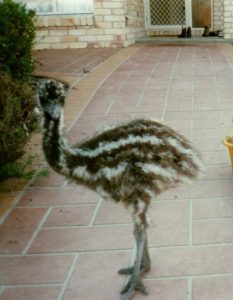
He was the sweetest little bird ever and became totally attached to me. When I went to town to shop, I had to lock him in a completely dark container, resembling being tucked under his father (yes, Emu chicks are reared by their fathers, not their mothers). He would sleep for the duration and become my shadow again as soon as I released him. At the same time Squeak was a juvenile, I also had four baby kangaroos and several lambs requiring a bottle of milk several times a day. The lambs were kept in the woolshed, approximately 350 metres from the house, and every time I trailed down to feed them, I resembled the ‘Pied Piper’. Squeak would accompany me, running along by my side on his strong, constantly growing legs, together with our dogs, three hand-reared fully grown kangaroos and my two pet milking goats. While he was still quite young, my mother came to stay for two weeks and helped me plant out my seedlings for spring. We chatted as we worked and when we finally reached the end of the garden bed, turned around to see Squeak carefully removing the last seedling from the ground. Every single plant had been removed. We had to lock him up and begin again.
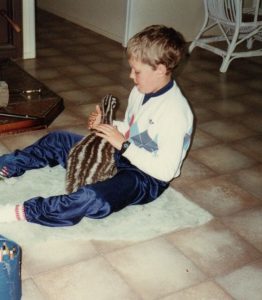 Squeak became more independent and grew tall, able to look me straight in the eye. As he reached this height, we noticed one of his legs failed to operate properly and he often fell over. A visit from a veterinary friend and fellow emu farmer confirmed our awful suspicions. Squeak was one of the unfortunate. Large birds sometimes develop a malfunctioning ball-in-socket problem with one or both hips. While this condition was not common, it was Squeak’s—and our—bad luck. There was no cure, no surgery available and no choice. Sadly, Squeak’s life came to a sad, but humane end.
Squeak became more independent and grew tall, able to look me straight in the eye. As he reached this height, we noticed one of his legs failed to operate properly and he often fell over. A visit from a veterinary friend and fellow emu farmer confirmed our awful suspicions. Squeak was one of the unfortunate. Large birds sometimes develop a malfunctioning ball-in-socket problem with one or both hips. While this condition was not common, it was Squeak’s—and our—bad luck. There was no cure, no surgery available and no choice. Sadly, Squeak’s life came to a sad, but humane end.
We continued farming Emus for a while longer, becoming quite attached to some of the birds, while the bank balance dropped alarmingly.
With the cost of keeping fifty adult Emus well fed and healthy, we made the decision to cut our losses and there ended our episode of Emu farming. It was a great learning experience and we had no regrets.
Learning so much about these wonderful birds became another chapter in the ups and downs of farming!
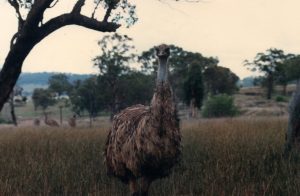
March 30, 2020
Percy and Sam – The Merinos
I have shared my life with many different pets and over the years, have reared hundreds of
orphaned lambs. Like everything, there are always those few that leave you with lasting
memories and were just that little bit more special. Percy and Sam were two Merino wethers
(desexed males) that fit this category.
Shearing in mid-winter is always fraught with anxiety – none more so that when the
ewes come in heavily pregnant due to the rams “getting to the girls” too early. With the stress
of shearing and cold, early births sometimes occur in the yards, the mother’s too confused or
frightened to know what has happened – and they re-join the flock, leaving their newborn
lambs on the ground. The year Percy and Sam were born was one of those years. When
shearing was over, there were eight motherless lambs, so of course, they were relocated to the house yard where a warm pen was prepared for them, and they began their lives with a bottle feed of artificial colostrum. From the beginning, Sam and Percy were the quiet lambs, the ones who loved nothing more than to lie in our laps and skip around the yard with my
children. As they grew up and returned to their role in the flock as wool-growers, they mostly
ignored us, with the exception of Sam and Percy. Both boys knew my voice and I’m quite
sure they also knew their names – I only had to call and they would come running out of the
flock to greet me.
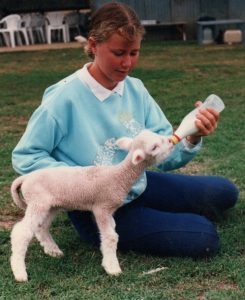
Percy had a comical way of galloping towards me, screeching to a halt at my feet (a
little disconcerting at times when he outweighed me), and gently pushing his head between
my knees, allowing me to scratch his velvety ears. Sam was always a little more aloof,
however the bonus of both these sheep was that neither ever threatened my children
(sometimes adult wethers and rams are inclined to show dominance by bunting or charging
humans, particularly the young and vulnerable).
As the wool market fluctuated and droughts, floods and wild dog attacks came and
went, our flock numbers varied, however Sam and Percy were always exempt. This was
partially due to their good wool which continued to fetch a reasonable price each year, but
mainly their longevity was due to their beautiful temperaments and quiet common sense.
Unlike many of their compatriots, they never tried to escape by crawling under fences
or leaping over them, they were never rough or domineering and above all, they were the
gentlemen that led the flock in an orderly fashion, into the yards when called. When the
movie “Babe” was released in the 1990’s, we were tempted to rename them “Maa 1 and Maa
2”.
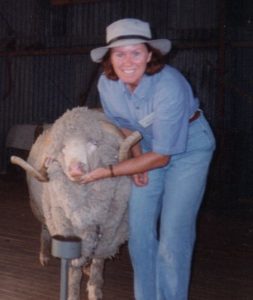
For most Australian bred merinos, reaching the age of ten is a challenge, however
Sam and Percy’s lives extended way past that. At almost thirteen, Sam sadly developed facial cancer and not long after, passed away. Percy continued to enjoy a sedentary life in the flock for a further three years, and at the ripe old age of sixteen, came to the homestead fence and lay down, waiting for me at the gate.
I sat down beside him and he laid his head on my lap. We sat for an hour or so before
he turned his head to look in my face. I swear he was thanking me. A few minutes later, he
passed away, leaving the whole family with a deep sadness but wonderful memories and
gratitude for having shared the life of such beautiful sheep.
January 15, 2020
Skippy – The Farm Kangaroo
I became a wildlife carer many years ago and over the years, dozens of macropods
(Kangaroos, Wallabies and Wallaroos in particular) came to live with me and my family.
Our very first kangaroo was a young, barely furred Eastern Grey Kangaroo doe. With
three primary school aged children at the time, she was named Skippy after the popular
Australian television show.

Skippy became a true family member and as she required three hourly feeds in the
early months, travelled everywhere with us. When in the house, she lived in a cotton lined old woollen jumper (sweater), suspended from a coat-hanger on the back of a chair. I sewed the bottom of the jumper up and cut a hole in the front – which she was then able to pop her head out of to watch what was going on. It was the closest pouch I could provide for her
resembling her own dead mother. After each bottle feed, I would lift her out, tightly snuggled
against me and hold her over the grass – where she would obligingly go to the toilet, allowing her pouch to remain clean and dry.

As Skippy grew, her fur became thicker, her personality developed and everyone delighted in having a kangaroo hopping around the house. She knew where her “pouch” was but frequently somersaulted into one of the family’s laps if they were curled up on the rug in
front of the fire. Within a few months, she preferred to spend longer and longer periods outside grazing on the lawn, but at the slightest unusual noise or change in the weather, she
would flee back to her “pouch” on the back of the veranda chair and dive in. As a treat, we would sometimes give her a small dish of dry rolled oats to eat. These became her favourite food and even in old age, she would hop to the kitchen door, bang on it and when let in, would head straight to the pantry where she knew the oats were kept.

When Skippy was around one year of age, the family went camping for the summer
holidays, leaving me at home to care for the farm and menagerie of orphaned animals. Of
course, as luck would have it, she became listless and unwell while everyone was away. I
rang the vet who admitted he didn’t have much knowledge of kangaroo illnesses, so I then
contacted an elderly couple I had met some time earlier. This couple had reared hundreds of
native animals of every breed, colour and size. As soon as I described Skippy’s symptoms, I
was told to take her to the vet and request he give her a vitamin B injection with selenium. I
followed their instructions and the very obliging and interested vet gave her the injection. As
she was unable to even hold her head up by then, we both knew her chances were slim. I took my very sick little kangaroo home again.
Having to attend an important function that evening, I wrapped Skippy up warmly and
left her in her bed in the kitchen. My heart was heavy as I believed it was highly likely that I
would not see her alive again. Amazingly, she had other ideas. As I put my key in the lock later that evening, I could hear a noise from inside, and was both shocked and delighted to have Skippy hop to the front door to meet me. I entered the kitchen, found the puddle she had produced (in my bare feet – a wonderful positive problem), and around twenty apples rolling around the floor. They had been removed from the box of fresh apples I had just purchased and all had one or two bites out of them. Skippy was well again! In the following years that Skippy lived with me, that was the only time she became ill. In spite of the dozens of macropods that we reared on Mirambeena, Skippy remained the only one who never left the farm to seek an independent life. With a lovely native bush adjacent to our property, most went in and joined the wild kangaroos and wallabies, but although Skippy would spend her days with them, she never went further than our boundary.
She sometimes spent days or even weeks without coming to visit the house, then would
simply turn up on the veranda, knock on the door wanting oats, and lie on her side in true
kangaroo style, across the doormat. When Skippy was in her third year of age, she began spending more time in the house yard again – never touching one of the plants in my one acre garden but enjoying the grass and lying under the washing line, particularly if it was full of washing flapping in the breeze. I noticed her pouch swelling and before long, a tiny head popped out to check on the outside world. The joey was named Matilda (once her gender was established), and following Matilda, Skippy went on to produce a joey every year for the next seventeen years. Initially we believed their father was either Banjo or Clancy – two of the male Eastern Grey Kangaroos that I reared in the subsequent year, however, as Clancy was killed on the road and Banjo disappeared after about six years, we had no idea who the father of all Skippy’s babies were. All of her female joeys remained with her on the farm, although were never as tame or as friendly as she was.
As if it was meant to be, my family gradually left one by one, and due to a health
issue, I decided the time was right for me to sell the farm. To this day I am sure Skippy
helped me make that decision, as my beloved long-time friend quietly passed away.
That was 2014 and she was in her twenty-first year.



